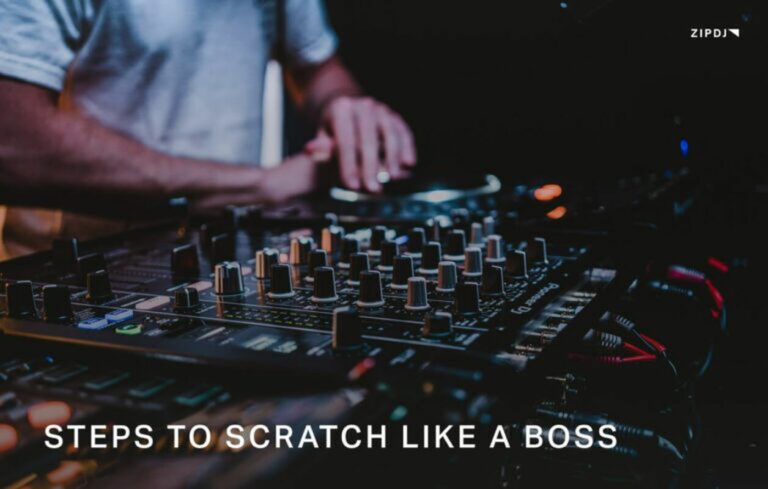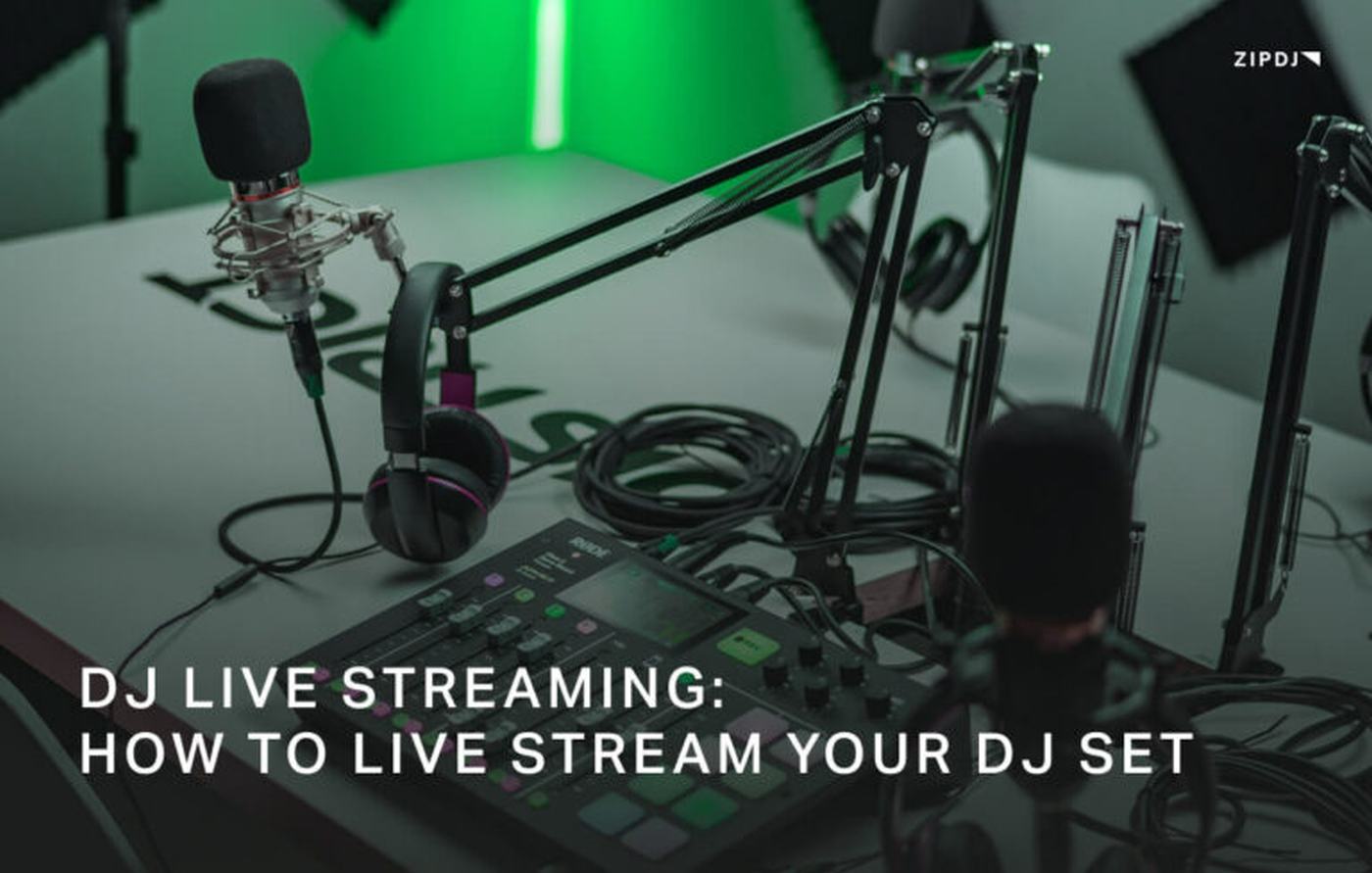Learn How To Scratch DJ: 10 Steps To Scratch Like A Boss

Learning how to scratch is one of the more difficult skills a DJ can learn, whether you’re scratching over instrumental tracks or using vocal snippets from funk and soul.
Once you’ve mastered scratching, you can take your sets to new heights, delivering performances that impress audiences worldwide.
Continue reading, and we’ll break down all the equipment you need to get started and various scratching techniques you can start learning today.

Learn How To Scratch DJ: 10 Steps To Scratch Like A Boss
Scratching techniques used by most DJs require a combination of the right equipment and tracks and a grasp of some fundamental principles.
We’ve outlined the optimal setup needed for scratching and a selection of basic and more advanced scratch techniques to get you started.
Without further ado, here’s our complete guide to learning how to scratch like a boss:
What Is Scratching?
The term “scratching” derives from the sound of a traditional vinyl record being forcibly rubbed backward and forward against a turntable needle.
During the 1940s, it was another term for back-cueing, when radio DJs would push the record back to the beginning of a song to allow for gapless playback.
It has since become synonymous with DJs who use it as another instrument in a mix, inserting various sounds over another record to add new rhythm and texture.
More recently, the technique has been adopted by DJs using modern controllers and CDJ players, with the jog wheel standing in for vinyl and moving similarly to create scratches.
Scratching can also be complemented with a range of easy DJ transitions to help bridge the gap between one track and the next.
What To Know Before Learning To Scratch
Mastering the art of scratching is one of the best ways to get DJ gigs, setting your skills apart from your competitors and allowing you to put on an impressive show.
Before you start, decide whether you prefer to use your left hand or your right hand since this will determine how you set up your equipment and cue tracks.
You’ll also need to pick between vinyl and CDs/digital files, as this will help you invest in the appropriate equipment depending on your preferred format.
Lastly, scratching well requires lots of practice, so consider recording a video of your mix to watch back and speed up the learning process.
How To Scratch (Step-By-Step)
Now that we’ve covered some of the history and applications of scratching, it’s time to explore how you can get set up to start learning some basic scratches.
If you want to see how these techniques are performed for yourself, you’ll find a free tutorial covering all these moves in the DJ scratch community to help you practice them.
Step 1: Choose The Right Equipment
Scratching is one of the best DJ tricks to improve your DJ skills, but without the correct equipment, you’ll struggle to pull it off.
First, you’ll need to decide whether to learn how to scratch with vinyl records or use a DJ controller, then invest in the appropriate equipment.
Whether you choose turntable scratching or a CDJ deck, you’ll also need a mixer with a decent crossfader curve with a “fast cut” setting required for scratch techniques.
Most professional scratch DJs use a turntable and vinyl disc, but some CDJs replicate the tension of turntables on a larger jog wheel, so they are fine for getting your scratch journey off the ground.
If you’re going this route, research the best digital controllers to practice scratching with before you invest your hard-earned cash in a setup.
Step 2: Select The Music To Scratch With
Scratch DJs use a variety of music genres to perform with, so choosing your genre and tracks is the next step you need to take.
Hip hop is perhaps the most iconic scratch genre, although it is possible to branch out and scratch with genres such as drum and bass and other styles.
Spend time researching where DJs get their music from, particularly those known for integrating scratching into their DJ sets.
If you’re using turntables, build up a collection of records to work with, or you can sign up to ZIPDJ and access an extensive archive of tracks, acapella, and samples.
Step 3: Consider Using Samples
If you’re looking into starting a DJ business and want to emphasize your scratching skills, you’ll need a great archive of music to scratch with when performing in venues.
An easy way to supplement your music library with scratchable elements is to use the right samples, which you can purchase individually or in sample packs.
This method benefits beginners, saving time hunting through songs to find usable portions of the track so you can practice scratching instantly.
Step 4: Master Your Crossfader
A DJ’s mixer is their most powerful tool and is used in many DJ techniques you need to master, including scratching.
While most mixers are suitable for general mixing purposes with a slow curve on the crossfader that slowly increases the volume on the incoming track, scratching requires one that delivers a fast cut.
This means the volume on the incoming song kicks in full as soon as the crossfader opens up the channel, allowing the scratch DJ to bring in a track quickly.
Whether you’re performing basic scratches or have moved on to advanced techniques, this fast-cut feature is crucial to perfecting the art form.
Before you learn how to scratch, ensure your crossfader is fit for purpose, making any adjustments to the mixer’s rotatable knob for altering the speed and checking preset curve settings.
Step 5: Start With The Baby Scratch
Now that you have everything set up, it’s time to begin this scratch tutorial in earnest with baby scratching, one of the most straightforward scratch techniques you can learn.
Begin by setting your marker in the center of the vinyl or jog wheel at the beginning of the sound you wish to scratch, with the crossfader set to open on both channels.
Start scratching by moving the vinyl/jog wheel back and forth over the starting position to perform the baby scratch on one beat, introducing accompanying music when you’re confident you have a good rhythm.

Step 6: Introduce The Scribble Scratch
A slightly more advanced scratch technique you can learn after mastering the baby scratch is the scribble scratch, performed with your fader on.
Again with a marker set at the beginning of the song segment of the sample, make a spasm-like motion as fast as possible over a short distance to create a quick scratching sound.
You can create scratch combos by combining the scribble scratch with a baby scratch and other more advanced scratching you pick up along the way.
Step 7: Learn The Drag Scratch
The drag scratch is another important foundational scratch technique, performed by moving back and forth over a single sound between the 9 and 12 o’clock positions.
Practice this without music, then introduce another track and perform the scratch on the cue point or at different intervals.
If you struggle to learn to scratch, don’t be afraid to hunt down video tutorials from other DJs on YouTube to master the basics.
Step 8: Add The Flare Scratch
To perform the flare scratch, begin with the crossfader open and move it quickly back and forth as you move the record over the scratch sample.
Multiple flare scratches can be performed for each move over the selected sample by bouncing the fade repeatedly, allowing you to perform two or three flare scratches for each movement of the record.
Flares scratches can be combined with other scratches to create a scratch combo, for example, the chirp flare scratch, which professional club DJs sometimes use.
Step 9: Include The Chirp Scratch
Named after the sound of a bird chirping, the chirp scratch is performed by playing the track forward and then cutting the fader as you return to the cue point.
Once you’re back at the start, open up the fader again for the forward motion, and repeat the procedure for the next chirp scratch.
This is a great scratching technique to help you to master back-cueing on the mixer, quickly muting and playing the sound in time with the rhythm.
Step 10: Master The Orbit Scratch
One of the more complicated DJ scratch techniques is the orbit scratch, sometimes referred to as the two-click flare.
Beginning with an open fader, close the fader twice as you move the record forward to create three distinct sounds, then close the fader twice as you reverse through the sample.
This technique delivers six sounds throughout one cycle and is best learned by performing it slowly without accompanying sound until you’re confident in your abilities.
If you’re live streaming your DJ set, this is a fantastic scratch you can impress your audience with once you’ve perfected the technique.
Learning How To Scratch DJ FAQs
We’ve covered many of the basics you need to know to help get you started on your scratch journey, but if you’re still unsure of anything, here’s a handy FAQ guide to this essential DJ skill.
1. What DJ Invented Scratching?
While scratching originally came from simply cueing up a record, in its modern context, it comes from Grand Wizard Theodore, who began moving back and forth on a record to avoid losing his position.
After hearing the scratches this motion made on the record, he decided to try and integrate it into a mix and play with the crossfader to explore new ways to play with the sound.
2. Is It Hard To Scratch?
Scratching can appear pretty simple, especially when watching professional DJs scratch, but it takes considerable time and practice to master fully.
Fortunately, there are several simple scratches you can pick up reasonably quickly, which can then be complemented with more difficult scratch tips as you become more proficient.
3. Which Hand Is Best For Scratching DJs?
Most DJs use their dominant hand when learning how to scratch, using this hand on the vinyl or jog wheel to move the track back and forth over the sample.
However, some world-class scratchers prefer to use their dominant hand on the fader, so newcomers to the craft should experiment to see which is most comfortable for them.
4. Does Scratching Damage A Record?
One of the main concerns when scratching traditional vinyl records is how much wear and tear the scratch technique has on records.
While scratching can wear down vinyl over time, keeping your collection clean and removing any fluff or dirt from the needle will minimize the impact on your records and equipment.
Summary
That wraps up this how-to guide to becoming a scratch DJ, so now you can learn these impressive techniques to show off on your DJ controller or turntable.
With additional moves such as the crab scratch, tweak scratch, and more to learn, it’s an art form you can learn at your own pace and practice alongside video tutorials.
Unlock your scratch DJ skills by signing up to ZIPDJs comprehensive DJ pool of music and samples you can use to master these techniques.
Not a member ?
Join Today for Unlimited Music Downloads. Visit zipdj.com for more information.



